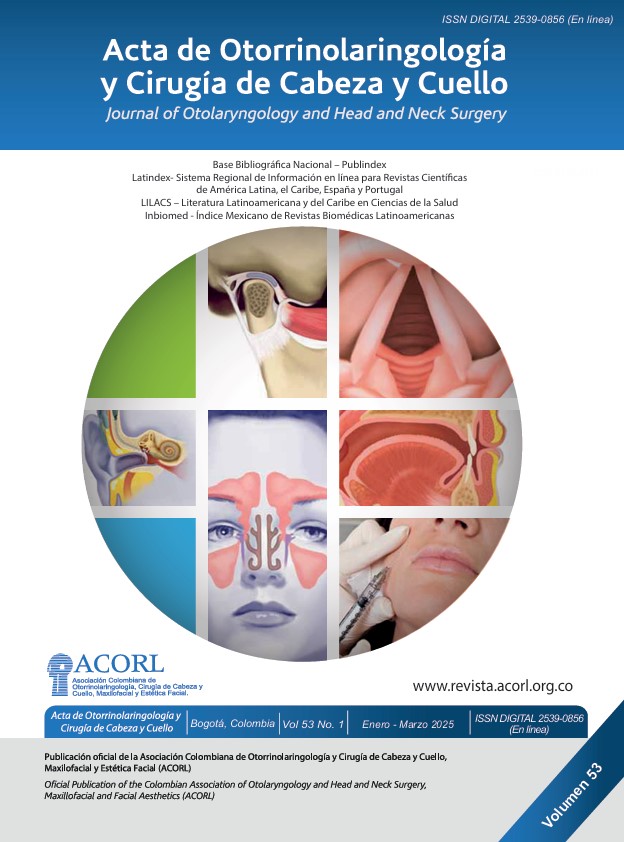Anatomical variables with potential risk profi le for papyrus lamina injury during nasal endoscopic surgery in computed tomography at the Hospital Militar Central
Main Article Content
Abstract
Introduction: Accidental damage to the lamina papyracea during endoscopic en donasal surgery is a common complication. Determining its position relative to the maxillary drainage ostium in preoperative tomographic analysis will allow us to reduce the risk of injury. Objective: This study aims to describe how these anatomical risk variables are distributed. This imaging assessment was performed using computed tomography images of healthy patients over 18 years old who attended the Central Military Hospital between June 2019 and April 2022. Study design: Descriptive observational cross-sectional study. Materials and methods: A sample size calculation was performed where 410 computed tomography scans of healthy adult patients’ paranasal sinuses were randomly selected. The position of the lamina papyracea on each side was categorized concerning the maxillary drainage ostium at the level of the inferior turbinate insertion in the lateral nasal wall. Results: A total of 410 tomographies were analyzed, revealing that the position of the lamina papyracea in relation to the medial antrostomy line (MAL) was classified as type I in 65.1% to 69.8% of cases, type II in 28.8% to 22.4%, and type III in 6.1% to 7.8%. These findings were consistent with previous studies, where type I was the most common position, followed by type II and, lastly, type III.
Downloads
Article Details

This work is licensed under a Creative Commons Attribution-ShareAlike 4.0 International License.
Este artículo es publicado por la Revista Acta de Otorrinolaringología & Cirugía de Cabeza y Cuello.
Este es un artículo de acceso abierto, distribuido bajo los términos de la LicenciaCreativeCommons Atribución-CompartirIgual 4.0 Internacional.( http://creativecommons.org/licenses/by-sa/4.0/), que permite el uso no comercial, distribución y reproducción en cualquier medio, siempre que la obra original sea debidamente citada.
eISSN: 2539-0856
ISSN: 0120-8411
References
Christmas DA, Mirante JP, Yanagisawa E. 25 years of powered endoscopic maxillary antrostomy. Ear Nose Throat J. 2017 Mar;96(3):94-98. doi: 10.1177/014556131709600304
Tajudeen BA, Kennedy DW. Thirty years of endoscopic sinus surgery: What have we learned? World J Otorhinolaryngol Head Neck Surg. 2017;3(2):115-121. doi: 10.1016/j. wjorl.2016.12.001
García-Garrigós E, Arenas-Jiménez JJ, Monjas-Cánovas I, Abarca-Olivas J, Cortés-Vela JJ, De La Hoz-Rosa J, et al. Transsphenoidal Approach in Endoscopic Endonasal Surgery for Skull Base Lesions: What Radiologists and Surgeons Need to Know. Radiographics. 2015;35(4):1170-85. doi: 10.1148/ rg.2015140105
Kennedy DW, Adappa ND. Endoscopic maxillary antrostomy: not just a simple procedure. Laryngoscope. 2011;121(10):2142 5. doi: 10.1002/lary.22169
Flint PW, Francis HW, Haughey BH, Lesperance MM, Lund VJ, Robbins KT, et al. Cummings Otolaryngology Head and Neck Surgery. 7.a edición. Philadelphia: Elsevier; 2021.
Seredyka-Burduk M, Burduk PK, Wierzchowska M, Kaluzny B, Malukiewicz G. Ophthalmic complications of endoscopic sinus surgery. Braz J Otorhinolaryngol. 2017;83(3):318-323. doi: 10.1016/j.bjorl.2016.04.006
Bhatti MT. Neuro-ophthalmic complications of endoscopic sinus surgery. Curr Opin Ophthalmol. 2007;18(6):450-8. doi: 10.1097/ICU.0b013e3282f0b47e
Humphreys IM, Hwang PH. Avoiding Complications in Endoscopic Sinus Surgery. Otolaryngol Clin North Am. 2015;48(5):871-81. doi: 10.1016/j.otc.2015.05.013.
Dalziel K, Stein K, Round A, Garside R, Royle P. Endoscopic sinus surgery for the excision of nasal polyps: A systematic review of safety and effectiveness. Am J Rhinol. 2006;20(5):506 19. doi: 10.2500/ajr.2006.20.2923
Bhatti MT, Schmalfuss IM, Mancuso AA. Orbital complications of functional endoscopic sinus surgery: MR and CT findings. Clin Radiol. 2005;60(8):894-904. doi: 10.1016/j. crad.2005.03.005
Demirayak B, Altintas O, Agir H, Alagoz S. Medial Rectus Muscle Injuries after Functional Endoscopic Sinus Surgery. Turk J Ophthalmol. 2015;45(4):175-178. doi: 10.4274/ tjo.01328
Herzallah IR, Marglani OA, Shaikh AM. Variations of lamina papyracea position from the endoscopic view: a retrospective computed tomography analysis. Int Forum Allergy Rhinol. 2015;5(3):263-70. doi: 10.1002/alr.21450
Meyers RM, Valvassori G. Interpretation of anatomic variations of computed tomography scans of the sinuses: a surgeon’s perspective. Laryngoscope. 1998;108(3):422-5. doi: 10.1097/00005537-199803000-00020
Hosemann W. Fehler und Gefahren: Eingriffe an den Nasennebenhöhlen und der Frontobasis unter Berücksichtigung mediko-legaler Aspekte [Comprehensive review on danger points, complications and medico-legal aspects in endoscopic sinus surgery]. Laryngorhinootologie. 2013;92 Suppl 1:S88 136. German. doi: 10.1055/s-0033-1337908
Nautiyal A, Narayanan A, Mitra D, Honnegowda TM, Sivakumar. Computed Tomographic Study of Remarkable Anatomic Variations in Paranasal Sinus Region and their Clinical Importance - A Retrospective Study. Ann Maxillofac Surg. 2020;10(2):422-428. doi: 10.4103/ams.ams_192_19
Mathew R, Omami G, Hand A, Fellows D, Lurie A. Cone beam CT analysis of Haller cells: prevalence and clinical significance. Dentomaxillofac Radiol. 2013;42(9):20130055. doi: 10.1259/ dmfr.20130055
Aramani A, Karadi RN, Kumar S. A Study of Anatomical Variations of Osteomeatal Complex in Chronic Rhinosinusitis Patients-CT Findings. J Clin Diagn Res. 2014;8(10):KC01-4. doi: 10.7860/JCDR/2014/9323.4923
Souza DAS, Costa FWG, de Mendonça DS, Ribeiro EC, de Barros Silva PG, Neves FS. Computed tomography assessment of maxillary sinus hypoplasia and associated anatomical variations: a systematic review and meta-analysis of global evidence. Oral Radiol. 2024;40(2):124-137. doi: 10.1007/ s11282-023-00726-2
Moulin G, Dessi P, Chagnaud C, Bartoli JM, Vignoli P, Gaubert JY, et al. Dehiscence of the lamina papyracea of the ethmoid bone: CT findings. AJNR Am J Neuroradiol. 1994;15(1):151-3.

